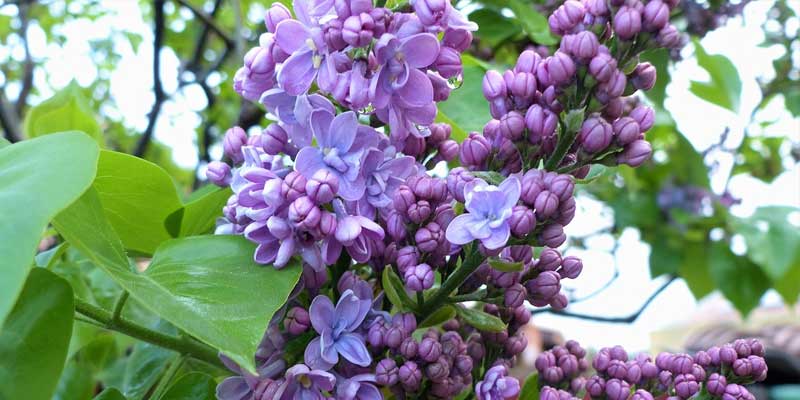Gardens worldwide cherish the enchanting fragrance and delicate blossom clusters of lilacs, belonging to the genus Syringa. Their beauty and resilience command admiration due to their resilient nature as shrubs. Yet, thriving like any plant necessitates proper care for lilacs; watering forms a fundamental aspect of maintaining them.
This comprehensive guide delves into the nuanced practice of watering lilacs. It offers invaluable insights into optimal frequency, which is a key determinant for ensuring vitality and longevity in these beloved shrubs.
Understanding Lilac Watering Needs
Before we delve into the frequency of watering, understanding both the specific needs of lilacs for water and the factors influencing their moisture requirements is crucial.
1. Soil Type and Drainage
Well-drained soil that retains moisture without becoming waterlogged is a preference for lilacs. Thriving in loamy soil with good drainage allows excess water to percolate away from the root zone, they avoid risks of root rot and other issues associated with excessive moisture.
However, note that heavy clay soils tend to hold onto water longer; thus elevating the risk of such problems due to increased periods of wetness.
On the other hand, sandy soils drain rapidly; as a result, one must manage more frequent watering to preserve optimal soil moisture levels.
2. Climate and Environmental Conditions
Temperature, humidity, and sunlight exposure: these environmental factors significantly influence the watering needs of lilacs. In hot, dry climates; frequent watering becomes a necessity, it prevents dehydration and alleviates plant stress.
Conversely in cooler more humid regions where natural moisture levels are higher; less frequent watering may be required. Additionally, windy conditions can accelerate soil drying, increasing the need for supplemental watering.
3. Establishment Phase vs. Established Plants
To establish a robust root system and stimulate healthy growth, one must regularly water newly planted lilacs. Throughout this crucial establishment phase, maintaining consistent soil moisture within the root zone is vital without saturating the earth with excessive water.
After typically completing their first growing season, established lilacs demonstrate an increased tolerance for drought conditions; consequently necessitating less frequent watering.
4. Mulching and Soil Moisture Retention
The application of an organic mulch – such as shredded bark or compost – around lilac shrubs’ base: this method not only conserves soil moisture but also regulates temperature fluctuations and suppresses weed growth.
Over time, as one continues to employ this practice; it improves soil structure and fertility – culminating in a favorable environment for robust root development.
Determining the Ideal Watering Frequency
Having explored the factors that influence lilac watering, let us now discuss: how frequently you should provide water to your lilac shrubs for their optimal growth and health.
1. Visual Soil Inspection
To determine the optimal watering time for your lilacs, employ this straightforward method: visually inspect the soil. Gauge moisture levels by inserting your finger into the base-adjacent soil; if it feels dry several inches below the surface – that’s your cue to water.
Should the soil retain moisture, refrain from watering; overwatering can culminate in root suffocation and fungal diseases.
2. Watering Schedule
To maintain consistent soil moisture levels and prevent drought stress in lilacs, establish a regular watering schedule. Aim for deep but infrequent waterings, permitting the soil to slightly dry out between each session.
Typically from spring through early summer – periods of active growth for lilacs – they may demand more frequent watering to foster flowering and foliage development. Monitor environmental conditions and adjust your watering frequency accordingly.
3. Morning Watering
Watering lilacs in the morning—allowing their foliage to swiftly dry—reduces the risk of fungal diseases, specifically powdery mildew. Avoid late-evening watering: overnight moisture on foliage can escalate disease development. Furthermore, by strategically implementing morning waterings; you guarantee your plants access to vital hydration during peak heat hours–a practice that minimizes stress and optimizes growth.
4. Rainfall Considerations
When determining your lilac watering schedule, consider the influence of natural rainfall. If regular rainfall characterizes your region, you may need to adjust accordingly.
Yet, remain vigilant against periods of drought or insufficient rainfall, particularly during summer months – provide supplemental watering as necessary to prevent moisture stress.
Conclusion
Understanding the unique watering needs of lilac shrubs in your garden is essential to their health and vitality; therefore, you must establish a regimen that promotes robust growth, abundant blooms, and overall plant health through proper watering. Prioritize soil moisture balance, and monitor environmental factors such as temperature and rainfall levels to adjust your watering frequency accordingly.
Additionally, employ mulching techniques for two crucial purposes – conserving moisture within the soil structure while enhancing its integrity. Your diligent attention to detail and care will ensure the flourishing of your lilacs, bringing you delight with their fragrant blossoms throughout each season.



Leave a Reply